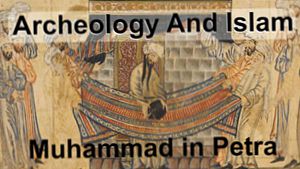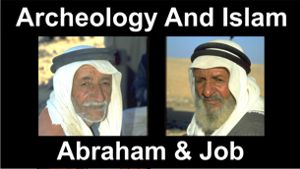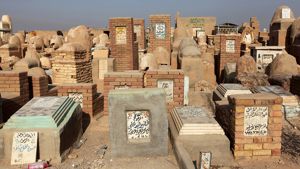Click below to watch the video:
Were Abraham and Job real historical people? What about the arguments that claim they never existed? … or that their histories are all wrong? What does modern archeological research tell us?
Transcript
Video #16 This is a general transcript of a Dan Gibson video in the series: Archeology and Islam.
Hello, and welcome to another video in the series Archeology and Islam. My name is Dan Gibson and today we want to examine a question that viewers have asked about the Prophets Abraham and Job, or in Arabic: أيّوب - إِبْـرَاهِـيْـم Ibrahim and Ayoub.
The reason for this is that many scholars cast doubt on the stories of Job and Abraham in the Bible, and in the Qur’an. They say that these stories are so ancient, that they just cannot be true. Now I cannot prove that they are true, but I think we can answer some of the objections they make against these prophets, such as their claims that the civilizations and peoples mentioned could not have been there at that time.
There are two types of arguments used against Job and Abraham. The first one is old: Absence of evidence is evidence of absence. What this means is, if the old records talk about an unknown group of people, or an unknown place, then these are just people or places that someone invented when telling the story. The argument is that they must be made-up places or people. So in this video we will examine some of these so-called made-up people.
The second argument is that the people, who are named, like the Chaldeans and Sabaeans in both stories, are way too early. These kingdoms didn’t exist until many years later. At least five to six hundred years. So the writers had to write after that time, they could not have written about them so early.
They are good arguments, but will they stand the test of archeology and the most recent discoveries?
So let’s start with the Chaldeans. This is one of the main arguments that I hear. These are mentioned in Job chapter one, verse seventeen. Three bands of Chaldeans attacked Job’s herd of three thousand camels, and they steal them away.
There are two arguments made: First they argue that camels had not been domesticated at this time, and second the Chaldean Empire came six hundred years later. The Chaldean argument is also raised against Ibrahim, as it says, he was from Ur and the Chaldees. (Genesis 11)
Again, mentioning Chaldeans far too early. This keeps coming up in the story because they were much later.
Well, let’s start with the idea of domesticated camels. I do not know who began this argument, but I know it was going strong in the 1940s, with Albright. He mentioning it, but since then a number of studies have been carried out on the domestication of camels in the Middle East, and that number keeps being pushed back to 2000 BC and then later pushed back to 3000 BC. Early on, Professor Edward Lipiński, stated: Camels seem to have been domesticated in Arabia since the 3rd millennium BC.
But there was no proof at that time, other than what he was pulling out of the records. But now several studies have come out in the last years, demonstrating that domestication of the camel in Arabia prior to 2000 BC, and petroglyphs occur on rocks in southern Jordan and Saudi. They confirm this; showing the presence of camels dating back to late 3rd millennium BC. So anyone who comes up with this argument about camels, it is a very old argument. It no longer stands. But I still hear some people using the domestication of camels as an argument. I am sorry. Camels were domesticated very early.
So that brings us to the Chaldeans, and the city Ur of the Chaldees.
First of all, some people point to the Chaldean Empire which existed from the 9th and mid-6th centuries BC and they claim that this is far too late for Job and Abraham.
Bible chronologists place the book of Job about 140 years before Moses. So they place the misfortunes of Job around 1640 BC, and so some archaeologists argue that the Chaldeans and Sabaeans left traces only from the 10th century BC., so they are 600 early.
Since Abraham left Ur around 1960 BC, it was too early for the Chaldeans and Sabaeans. And at that time Ur was in the land of Sumer, and his city was ruled over by the people of Sumar, not the Caldeans.
The arguments sound convincing at first… until we just think about it for a few minutes.
First of all, Abraham was not a Sumerian nor a Babylonian. He was a Hebrew, a descendant of ‘Eber. We have his genealogy. Like most of the inhabitants of Sumer, they were not actually Sumerians, whose language and ethnic background collapsed in 1912 BC.
So someone writing during the time of the Chaldeans, later, would have referred to the city as “Ur of the Chaldees” in much the same way that I refer to Petra of Southern Jordan, rather than Petra of the Nabataeans, or Petra of the Romans, or Petra of the Byzantines, or Petra of the… well, you pick whoever you want to pick.
So the term Ur of the Chaldees tells us more about when the story was written down, and not when it actually took place.
Also remember, that there are areas of Ur that were in southern Babylonia, this was marsh lands.
And the Babylonians set aside as a city there for wisdom, for study, for philosophers, and for astronomers. The people there had occupations like this and they were called Chaldeans because of their occupation.
At the same time, Strabo also tells us that there were ethnic people called Chaldeans, and he gives us the names of some of the sub-tribes, like ah, the Urukeans and Borsippeans, or whatever. (Geography XVI:1:6)
So, I remember once, a historian who was reviewing something I had written, and he looked at when I wrote Petra in Jordan, and he said, no no, you are writing about the time of Muhammad. You shouldn’t say Petra in Jordan, because Jordan is modern, and Muhammad is ancient. You are putting these two things together.
The reason I did that was to clearly communicate what city I was talking about to my audience. I was thinking of my modern audience, not some academic audience, of whom I have great appreciation.
In the same way, the writers of the Biblical record of Job and Abraham, which has traditionally been considered as Moses, he was communicating to his audience that Abraham came from Ur of the Chaldees. Now this said a lot. His family was part of the educated, philosophers and thinkers family of his day. This was during the time that Ur was actually under Sumer but his audience didn’t know Sumer, they were aware of Ur of the Chaldees, because he was writing much later. So they were aware of that, so that’s how he made his identification.
So there should not be an issue for writers identifying Abraham from being from there, because he’s trying to say, he is from that city … from those people.
This is why it is mentioned. Abraham did what was not expected of him. He turned his back on the education and all of the prestige of that city. (Genesis 12:4-5) He went out and became a nomad. And he was trusting selves Mesopotamian, yet I know people applying the Greek term to them all the time.

Map of the Geographical Distribution of the Semitic Languages in their original homelands.
Now if you want to investigate the background of the Chaldean tribe, before they set up their kingdom in southern Babylon, or should I say Iraq, or is it called Mesopotamia, no that is a Greek term, the Babylonians never called them
It is not Mesopotamia, is it Sumar, Babylon, Akkad, There are so many different names here. But the Chaldeans, they were in the Levant, they moved over to Babylon. So what does this mean? The Chaldeans tribes, when they attacked Job, they fit the chronology because at the time they were nomads. They spoke the West Semitic language.
They moved over to Babylon and there they became part of the Chaldeans, in Babylon and set up their kingdom there. So the problem of having, Ur of the Chaldees, or Ur of Babylon, or Ur of Sumar, or Ur of Iraq, there is, all about when it was written, rather than the time they were writing about.
Now if you examine history using timelines, then these terms are not such an issue. Even the Sabeans, who were nomadic at the time, were traveling slowly south at the time towards Yemen where they would eventually set up a kingdom.

Timeline
They were nomads at the time of Job; later they had their kingdom, so they fits absolutely perfect.
And do you remember what we said back in the previous video? Nomads leave very little archeological evidence. No great cities, no great stones, nothing behind.
Now I lived with the Bedouin for a number of years, and while there I heard a number of their stories about tribal nomadic sheiks from several hundred years ago. They were famous in their day. But they never built a building, never wrote their names on stone, and never minted any coins. The only place that they survive is in the tribal chronologies memorized by the tribes, and in the poems and stories written about them.
The other day I was cleaning out a drawer and I came across some old cassettes and floppy discs. Do you remember those? Cassettes were invented in my lifetime! In 1962! And already they are disintegrating. That’s right.
Cassettes and 8 tracks were invented within two years of each other. I was less than ten years old. Now in my life time they stretched with magnetic stuff falling off of them.
I remember riding in an old beat up truck, driven by some Bedouin in the dessert, and he had a dozen cassettes all just on the dash of the truck. Do you remember those days? and he would stop and pull out tape and get a stick and try to dig it out, and then wind it back up and stick it so he could still listen to it. And so, those were the old days.
I think there are bits and pieces of broken cassette tapes all over the deserts of Arabia. What a horrible failure. And among the debris are now broken CDs, I see them there, and the silver coming off of them and so forth.
You see all down through history, mankind has struggled to find a good way to preserve knowledge. What lasts, long enough to pass knowledge from one generation to another? Everything we use is fragile. Paper has been a pretty good for the last few years but it is not perfect.
I remember a lady who owned hundreds and hundreds of books. She lived in the Emirates, and one time she decided to go back to the west to get more education. So she packed up all her books and all her belongs and put them into wooden crates and they were to be placed in storage. Or so she thought.
Actually, they were supposed to go into storage, but they sat outside in the sand for a few months, temporarily forgotten. Then I got a job working there, and one day I asked about those crates sitting outside in the sand. Somebody said: Oh I remember about this lady… So I got the tractor and we got the men to help. And we moved these boxes and we got them on the cement area.
And I opened them up and guess what I found. Termites had built their tunnels into the bottom of the crate. Termites love wood, but they love paper even better: pre-digested processed wood, they love it!
And the books in the crate were riddled with termite holes, going every which way in them. They spread … we spread them out and we had to go through and try to go through those books, and threw out a lot of books because termites destroy.
Fire destroys, war destroys, floods destroy; they can all damage books.
The great libraries of Alexandria and Celsus and Pergamum and Tesephon are all stark eminders of how fragile paper is; or velum or whatever we are writing on. So if you were wealthy, you could write on stone, Perhaps on the walls of a temple, or a memorial stone you could set up. You could hire a scribe to write on clay tablets. If you were not wealthy, you could even put a few lines on a rock in the desert while you were watching the sheep. But none of those contain long inscriptions. There is no poetry, or long histories, or chronologies on the desert rocks.
But the Bedouin in Arabia found a way to preserve knowledge over multiple generations. It was called poetry. But this poetry wasn’t written in books. It was written on the hearts of men and women. You see, a good poem just sticks with you.
When I was in high-school, many years ago, I read a good poem. I was fascinated by it. And so I started to memorize it. It was called “The Cremation of Sam McGee.” (By Robert Service). It starts like this: (from memory)
There are strange things done in the midnight sun
By the men who moil for gold;
The Arctic trails have their secret tales
That would make your blood run cold;
The Northern Lights have seen queer sights,
But the queerest they ever did see
Was that night on the marge of Lake Lebarge
I cremated Sam McGee.
Now Sam McGee was from Tennessee, where the cotton blooms and blows.
Why he left his home in the South to roam ‘round the Pole, God only knows…
You see, that’s just the beginning. It goes on, and on and on. And even I misquoted it and I missed one line, and so you see, poetry is there, but people say … See, it’s not good because you misquoted it.
But the beauty of poetry is that you meet other people, and you quote the poem and they correct you because they have also memorized, and so it is corrected by each other. And that happened to me just a few weeks ago; with that very poem. And I got corrected. and I thought, you know what? You are right, I did! I missed a piece in that poetry.
I have seen that scenario in Bedouin tents: People who neither read nor write, repeating line after line of ancient poetry.
Then… every once in a while I am in some academic setting, and someone will make a derogatory remark about the inaccuracy of orality; and I cringe. There is nothing worse than being corrected by a whole room full of people, when you are trying to repeat a famous story. I remember hearing a Bedouin recite the genealogy of his tribe, going back for generations after generations. And he stumbled. And two other older men corrected him; in a nice way. They prompted him. They encouraged him.
In this day and age of television and internet, I know it is hard to imagine a group of people sitting around the glowing coals of a fire, in the pitch black night, reciting poetry in the desert, or some ancient genealogy. In homes all across the Muslim world, children memorize sections of the Qur’an. And Bedouin, many who cannot read or write will gather for Friday prayers, and will recite together from the Qur’an.
And in other parts of the world, Christians will memorize parts of the Bible. I have met people who have memorized large parts of the Bible. Whole sections are memorized. Friends, orality is alive and well in some parts of the world.
When war ravages, when electricity fails, when fires destroy and flood wash away, all that may survive is the knowledge that is hidden away in the heads of those who memorize. If you think that once something is digitized, it is preserved forever, think again. The digital age is only a few decades old. I wonder how long our digital records will last. Just go to Iraq or Syria and see how much as survived there after the war. The next major world war may wipe out a great deal of the world’s knowledge. But the poetry and genealogies and the memorized verses of religious wisdom I think will survive, to be written down again, in that post-apocalyptic world.
Now, let’s go back to Job and Abraham. We have their stories. Not written in stone, but written in Old Hebrew. Yes, in the Qumran caves, where they discovered those ancient manuscripts, they found many scrolls including parts of Genesis, Exodus, Leviticus, written in palaeo-Hebrew; the earliest form of the Hebrew languages. Also a copy of Job is written there.
Palaeo-Hebrew and Proto Cananinte dates back to 1550-1480 BC. They are amazingly close, to the much later stone found at Tel Zayit which contained paleo-Hebrew from five hundred years later.
We don’t have time for all the arguments made against Abraham, but a main one is about a man named Chedorlaomer and his campaign against Sodom. The New Testament mentions this, so it was taken as a true story. (Hebrews 6:20-7:2)
Now, one of the problems is that not all of history is fixed. For instance, the Babylonian chronology is not fixed. Arguments are still made by scholars about different kings and different times. So anyone who claims that scholars are 100% sure that that this man never existed, are just trying to convince you.
Now, when T.G. Pinches (1856-1935), He was an Assyriology at the University of London and at the University of Liverpool, he published his writings back then and he came up with all different kinds of names. And he tried to line up different kings, with the different kings his work was thrown away. Scholars proved it was not the connections he was trying to make. What happened was, because the first identification failed, of who this man was, it was assumed that all would fail. And it all passed away.
But recently, a paper called: Abraham and Chedorlaomer, Chronological, Historical and Archaeological Evidence changed all that. The author linked Chedorlaomer with Kudurkukumal a king of Elam, and he made many very persuasive arguments. His paper is freely available on the internet. I have read it in detail. Others, such as Dr. Hermann Hunger, Professor of Assyriology of the University of Vienna, he has examined this paper, and have written papers in support of it.
So anyone who claims that Chedorlaomer never existed is accepting an argument from made, that was made over a century ago, without any regard to modern research.
So what does this tell us? First of all, many of the old arguments used against Abraham and Job no longer stand. One by one, archeologists are uncovering evidence that supports the existence of these men and the story that was written long ago.
The main argument against the existence of Job and Abraham now, is that the scholars personally prefer not to believe in them. That is just their choice. In some cases they make a judgment call, but there is certainly no outstanding claims against what has been written down … that these are very old stories, and that they date back to the times that they claim to date. But, as it has always been with the prophets, it is a personal choice whether someone accepts and follows them. I cannot prove them to you. At some point archeology ends, and faith begins.
That is why, as a historian, I am interested in the historicity of the early prophets. And as I have studied it, up to the time of Jesus, I find them sound. There is evidence to support them. But when I came to Muhammad, I began to find a different story. Mosques were pointing to Petra not Mecca. All kinds of circumstantial evidence supported Petra in modern day Jordan, not Mecca in Saudi Arabia.
And so that is why we are writing these books and making these videos; trying to figure this out.
I am Dan Gibson, and this has been another video in the series: Archeology and Islam.
Credits and Thanks
M Lubinski - photos of Ur
Mbzt 2012 - photo of Mesha Stone
Bala Subramanian - temple inscription photo
BabelStone - Babylonian Inscription photo
Jadd Haidar - photo of Bosra Camel Mosaic






























Page Discussion
Membership is required to comment. Membership is free of charge and available to everyone over the age of 16. Just click SignUp, or make a comment below. You will need a user name and a password. The system will automatically send a code to your email address. It should arrive in a few minutes. Enter the code, and you are finished.
Members who post adverts or use inappropriate language or make disrespectful comments will have their membership removed and be barred from the site. By becoming a member you agree to our Terms of Use and our Privacy, Cookies & Ad Policies. Remember that we will never, under any circumstances, sell or give your email address or private information to anyone unless required by law. Please keep your comments on topic. Thanks!